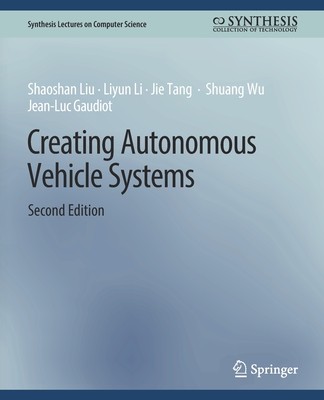
- We will send in 10–14 business days.
- Author: Shaoshan Liu
- Publisher: Springer
- ISBN-10: 3031006771
- ISBN-13: 9783031006777
- Format: 19.1 x 23.5 x 1.3 cm, minkšti viršeliai
- Language: English
- SAVE -10% with code: EXTRA
Reviews
Description
This book is one of the first technical overviews of autonomous vehicles written for a general computing and engineering audience. The authors share their practical experiences designing autonomous vehicle systems. These systems are complex, consisting of three major subsystems: (1) algorithms for localization, perception, and planning and control; (2) client systems, such as the robotics operating system and hardware platform; and (3) the cloud platform, which includes data storage, simulation, high-definition (HD) mapping, and deep learning model training. The algorithm subsystem extracts meaningful information from sensor raw data to understand its environment and make decisions as to its future actions. The client subsystem integrates these algorithms to meet real-time and reliability requirements. The cloud platform provides offline computing and storage capabilities for autonomous vehicles. Using the cloud platform, new algorithms can be tested so as to update the HD map--in addition to training better recognition, tracking, and decision models.
Since the first edition of this book was released, many universities have adopted it in their autonomous driving classes, and the authors received many helpful comments and feedback from readers. Based on this, the second edition was improved by extending and rewriting multiple chapters and adding two commercial test case studies. In addition, a new section entitled "Teaching and Learning from this Book" was added to help instructors better utilize this book in their classes. The second edition captures the latest advances in autonomous driving and that it also presents usable real-world case studies to help readers better understand how to utilize their lessons in commercial autonomous driving projects. This book should be useful to students, researchers, and practitioners alike. Whether you are an undergraduate or a graduate student interested in autonomous driving, you will find herein a comprehensive overview of the whole autonomous vehicle technology stack. If you are an autonomous driving practitioner, the many practical techniques introduced in this book will be of interest to you. Researchers will also find extensive references for an effective, deeper exploration of the various technologies.EXTRA 10 % discount with code: EXTRA
The promotion ends in 21d.22:39:52
The discount code is valid when purchasing from 10 €. Discounts do not stack.
- Author: Shaoshan Liu
- Publisher: Springer
- ISBN-10: 3031006771
- ISBN-13: 9783031006777
- Format: 19.1 x 23.5 x 1.3 cm, minkšti viršeliai
- Language: English English
This book is one of the first technical overviews of autonomous vehicles written for a general computing and engineering audience. The authors share their practical experiences designing autonomous vehicle systems. These systems are complex, consisting of three major subsystems: (1) algorithms for localization, perception, and planning and control; (2) client systems, such as the robotics operating system and hardware platform; and (3) the cloud platform, which includes data storage, simulation, high-definition (HD) mapping, and deep learning model training. The algorithm subsystem extracts meaningful information from sensor raw data to understand its environment and make decisions as to its future actions. The client subsystem integrates these algorithms to meet real-time and reliability requirements. The cloud platform provides offline computing and storage capabilities for autonomous vehicles. Using the cloud platform, new algorithms can be tested so as to update the HD map--in addition to training better recognition, tracking, and decision models.
Since the first edition of this book was released, many universities have adopted it in their autonomous driving classes, and the authors received many helpful comments and feedback from readers. Based on this, the second edition was improved by extending and rewriting multiple chapters and adding two commercial test case studies. In addition, a new section entitled "Teaching and Learning from this Book" was added to help instructors better utilize this book in their classes. The second edition captures the latest advances in autonomous driving and that it also presents usable real-world case studies to help readers better understand how to utilize their lessons in commercial autonomous driving projects. This book should be useful to students, researchers, and practitioners alike. Whether you are an undergraduate or a graduate student interested in autonomous driving, you will find herein a comprehensive overview of the whole autonomous vehicle technology stack. If you are an autonomous driving practitioner, the many practical techniques introduced in this book will be of interest to you. Researchers will also find extensive references for an effective, deeper exploration of the various technologies.

Reviews